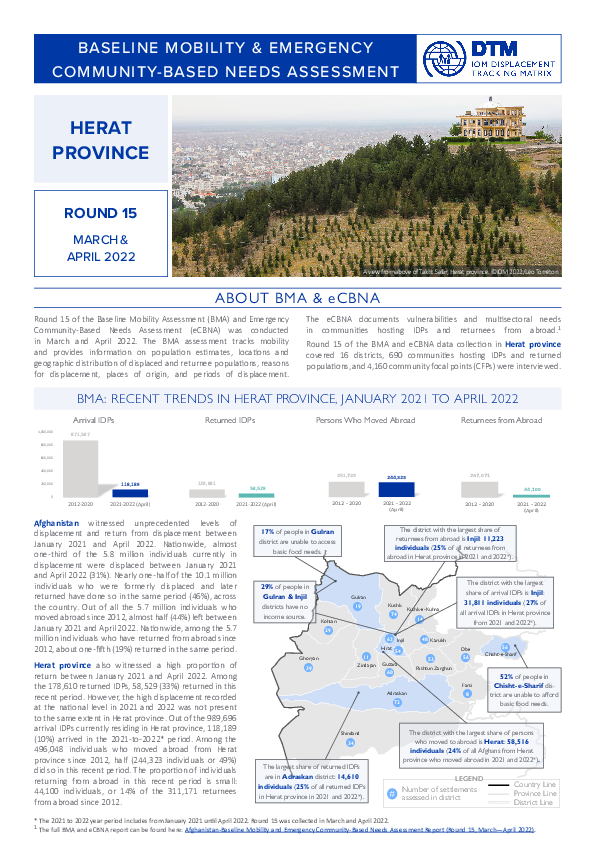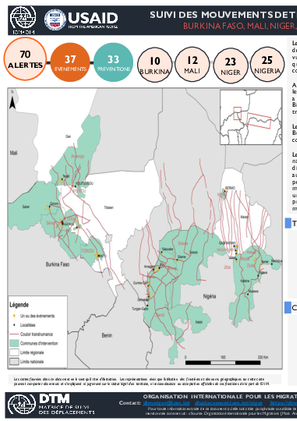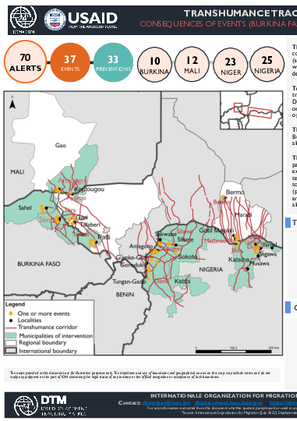-
Countries
-
Data and Analysis
-
Special Focus
-
Crisis Responses

Contact
DTM Sudan; dtmsudan@iom.int
Language
English
Location
Sudan
Snapshot Date
Aug 03 2022
Activity
- Mobility Tracking
- Event Tracking
The DTM Emergency Event Tracking (EET) is deployed to track sudden displacement and population movements, provide more frequent updates on the scale of displacement, and quantify the affected population when needed. As a subcomponent of the new Mobility Tracking methodology in Sudan (Round Four), and activated on a need basis, EET utilises a broad network of key informants to capture best estimates of the affected population presence per location – a useful tool for humanitarian response planning and design.

Contact
DTMcovid19@iom.int
Language
English
Location
Global
Period Covered
Jun 04 2022
Aug 01 2022
Activity
- Other
The DTM Global Mobility Restrictions Overview provides updates on international air travel restrictions and conditions for authorized entry. This overview aims to understand how COVID-19 has impacted human mobility, detailing how global and regional trends in air travel measures have evolved since COVID-19 was declared a global pandemic in March 2020. The data presented focuses on the changes in public health-related immigration and border management measures. It provides information intended to support IOM missions and partners in targeted response planning and advocacy for vulnerable populations who may be affected by changes in global mobility.

Contact
DTM Nigeria, AllUsersInDTMNigeria@iom.int
Language
English
Location
Nigeria
Period Covered
Jul 25 2022
Jul 31 2022
Activity
- Mobility Tracking
- Event Tracking
The DTM Emergency Tracking Tool (ETT) is deployed to track and to collect information on large and sudden population movements, provide frequent updates on the scale of displacement and quantify the affected population when needed. As a sub-component of the Mobility Tracking methodology in Nigeria, ETT utilises direct observation and a broad network of key informants to capture best estimates of the affected population per location, enabling targeted humanitarian response planning.
Between 25 and 31 July 2022, a total of 3,878 new arrivals were recorded in Adamawa and Borno States. The new arrivals were recorded at locations in Askira/Uba, Bama, Damboa, Dikwa, Gwoza, Kala Balge, Monguno and Ngala Local Government Areas (LGAs) of the most conflict-affected state of Borno and in Demsa, Fufore, Girei, Gombi, Hong, Lamurde, Maiha, Michika, Mubi North, Mubi South, Numan, Song, Yola North and Yola South LGAs of Adamawa State.
ETT assessments identified the following movement triggers: military operations (1,600 individuals or 41%), improved security (1,114 individuals or 29%), poor living conditions (544 individuals or 14%), family re-unification (257 individuals or 7%), seasonal farming (218 individuals or 5%) and access to humanitarian support (145 individuals or 4%).
Afin de mieux comprendre les tendances des mouvements transhumants et l’impact des fragilités sur les communautés transhumantes, l’OIM, au travers de sa Matrice de suivi des déplacements (Displacement Tracking Matrix DTM), a déployé l’outil de suivi de la transhumance (Transhumance Tracking Tool – TTT) avec le Réseau Bilital Maroobe (RBM) et ses antennes d’organisations d’éleveurs pour faire le suivi dans les zones transfrontalières des pays d’intervention du RBM.
Le TTT permet de comprendre les dynamiques liées à la transhumance transfrontalière entre le Burkina Faso, le Niger, le Nigéria et le Mali. Il combine trois composantes : la cartographie, le comptage et l’alerte.
Le système d’alerte a pour objectif de recenser les évènements liés à l’utilisation des ressources naturelles, aux pratiques agro-pastorales, ainsi qu’aux catastrophes dans la région transfrontalière de différents pays, de comprendre les modes de résolution de conflits existants et d’informer les autorités compétentes afin de réduire les tensions dans les communes d’intervention. Ce système permet de recenser les alertes liées à un évènement conflictuel (alerte évènement) ou à un mouvement massif, précoce, tardif ou inattendu de bétail (alerte prévention) qui pourrait provoquer un conflit. Ces alertes, une fois transmises aux différents acteurs, sont utilisées pour des actions de prévention ou de résolution de conflits. Ce rapport présente les données de l’outil d’alerte pour les mois de mai à juin 2022.
To better understand transhumant movement trends and the impact of vulnerabilities on transhumant communities, IOM has deployed the Transhumance Tracking Tool (TTT), through its Displacement Tracking Matrix (DTM), with the Bilital Maroobe Network (RBM) and its pastoralist organization branches to monitor transhumance in cross-border areas in countries where RBM operates.
The TTT provides an understanding of the dynamics of cross-border transhumance between Burkina Faso, Niger, Nigeria and Mali by combining three components: mapping, counting and alerting.
The purpose of the alert system is to identify events related to the use of natural resources, agro-pastoral practices, and disasters in the cross-border area of different countries, to understand the existing conflict resolution methods, and to inform competent authorities in order to reduce tensions in the municipalities of intervention. This system makes it possible to identify alerts related to a conflict event (event alert) or to a massive, early, late or unexpected movement of livestock (prevention alert) that could lead to conflict. These alerts, once transmitted to the various actors, are used for conflict prevention or actions towards resolutions. This report presents data from the alert tool for the months of May through June 2022.
Statut des sites spontanés ouverts à partir du 24 avril à cause de violences dans la zone métropolitaine de Port-au-Prince, au 1 août 2022.

Contact
DTM Uganda, dtmuganda@iom.int
Language
English
Location
Uganda
Period Covered
Jul 01 2022
Jul 31 2022
Activity
- Mobility Tracking
July was characterized by floods and Mudslide in the eastern region (Elgon sub region) which were triggered by heavy and extended rains on the 30th and 31st of July 2022. Transport related accidents were also reported in Wakiso district. o A total of 12,202 individuals were affected, representing 2,692 households. 6,630 individuals from 1,105 households were internally displaced by the disasters. o Adults (19-64) were the most affected population group (49%), followed by children under 18 (34%) and the elderly above 64 (17%). o The most pressing needs are health, shelter, education and non food items. o So far in 2022, 80,568 individuals have been affected by disasters, representing 15,800 households. A total of 11,945 individuals representing 3,668 households have been internally displaced. o The Kisoro refugee status stand at 41,120 refugees received in Uganda and 17,874 at the holding and transit center

Contact
DTM Colombia, DTMColombia@iom.int
Language
Spanish
Location
Colombia
Period Covered
Jul 01 2022
Jul 28 2022
Activity
- Flow Monitoring
El 87% de los nacionales venezolanos entrevistados(as) indican que proceden de la República Bolivariana de Venezuela, destacándose que el 15% provienen del Distrito Capital y Zulia cada uno y el 9% de Carabobo. En una proporción menor provienen de otros países como: Perú (6%), Ecuador (6%) y Chile (2%)

Contact
DTMAfghanistan@iom.int
Language
English
Location
Afghanistan
Period Covered
Mar 01 2022
Apr 30 2022
Activity
- Mobility Tracking
- Site Assessment
- Baseline Assessment
DTM has been conducting the Baseline Mobility Assessment in Afghanistan since 2016 to track mobility, provide information on population estimates, locations and geographic distribution of displaced and returnee populations, reasons for displacement, places of origin and periods of displacement. Vulnerabilities and multi-sectoral needs are covered in the Emergency Community- Based Needs Assessment (eCBNA) at the end of the report. Data is collected at the settlement level, through focus group discussions with community focal points and direct observations.
This province highlight delves into the key findings in Nangarhar province using the latest results from Round 15 of the BMA and eCBNA (conducted in March and April 2022), focusing on the 2021-to-2022 period. The full report can be found here: Baseline Mobility and Emergency Community-Based Needs Assessment Report (Round 15, March—April 2022)

Contact
DTMAfghanistan@iom.int
Language
English
Location
Afghanistan
Period Covered
Mar 01 2022
Apr 30 2022
Activity
- Mobility Tracking
- Site Assessment
- Baseline Assessment
DTM has been conducting the Baseline Mobility Assessment in Afghanistan since 2016 to track mobility, provide information on population estimates, locations and geographic distribution of displaced and returnee populations, reasons for displacement, places of origin and periods of displacement. Vulnerabilities and multi-sectoral needs are covered in the Emergency Community- Based Needs Assessment (eCBNA) at the end of the report. Data is collected at the settlement level, through focus group discussions with community focal points and direct observations.
This province highlight delves into the key findings in Herat province using the latest results from Round 15 of the BMA and eCBNA (conducted in March and April 2022), focusing on the 2021-to-2022 period. The full report can be found here: Baseline Mobility and Emergency Community-Based Needs Assessment Report (Round 15, March—April 2022)



